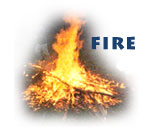|


Fire is referred
to extensively in the aggadah. According to one account, fire was created on
the second day of creation, but according to another, it was created after the
conclusion of the Sabbath, when Adam rubbed together
two stones, using the friction to produce the first fire.[1]
Several rabbis accepted the legend that the salamander was created out of fire[2]
and that its blood could thereby protect a person from the ill effects of fire.
According to another aggadah, fire was a primordial creation, from which was
created light.
Three creations preceded the making of the world: water, wind (spirit) and fire.
Water conceived and gave birth to thick darkness, fire conceived and gave birth
to light, wind (spirit) conceived and gave birth to wisdom. The world is maintained
by means of these six creations: by wind (spirit), wisdom, fire, light, darkness
and water.[3]

The
rabbis regarded all that which comes directly from God as having been
given in fire. The Torah, for example, is describing as being given in
a frame of white fire and the letters were engraved in black fire [4]
When God told Moses to institute the half-shekel, He showed him "a
coin of fire." [5]
Simultaneously, with earthly fire was created the fire of Gehinnom
(Hell), and earthly fire is one sixtieth of that fire. [6]
The fire on the Temple altar is included among the ten miracles the rabbis
claim were wrought for our fathers during Temple times. The fire of the
altar came down from heaven, and remained burning from the time of Moses
until it was transferred to the Temple of Solomon. Despite the fact that
the altar was under the open sky, the rain never quenched the fire of
the woodpile, and it continued to burn until the reign of Manasseh. Although
the fire in the Second Temple period was human fire (unlike that in the
First Temple which came down from heaven), it, too, was never extinguished
by the rain. [7]
It is taught: Five things were reported about the fire of the woodpile
on the altar: It lay [powerful] like a lion, it was clear as the sun,
its flame was of solid substance, it consumed freshly cut wood as though
it were dry wood, and it caused no smoke to rise from it. It lay like
a lion? But has it not been taught that R. Hanina, deputy high priest,
had said: "I myself saw it, and it lay low like a dog"? [The
answer is]: The first description refers to the First Temple, the second
to the Second Temple. [8]
 Our
master taught, too, that there are six kinds of fire: Our
master taught, too, that there are six kinds of fire:
Fire that devours but does not lap up: that
is our fire [which is quenched by water];
Fire that laps up but does not devour: a sick man's fever;   Fire
that both devours and laps up: that of Elijah, of which it is written, "It
lapped up the water that was in the trench" (I Kings 18:38) Fire
that both devours and laps up: that of Elijah, of which it is written, "It
lapped up the water that was in the trench" (I Kings 18:38)
Fire that devours moist matter as well as dry matter: the fire of the
woodpile on the altar; 
 Fire
that pushes another fire away: such as that of Gabriel the angel, who
went down into the furnace into which Hananiah, Mishael and Azariah
had been cast, and pushed away the fire; Fire
that pushes another fire away: such as that of Gabriel the angel, who
went down into the furnace into which Hananiah, Mishael and Azariah
had been cast, and pushed away the fire;
And fire
that devours fire: that of the Presence, concerning which a master said, "He
put forth His finger among the angels and incinerated them." [9]

|
[1]
BT, Pes. 54a [back]
[2] BT, Hag. 27a; Tanh. Vayeshev 3,
Ex. R. 15:28 [back]
[3] Exodus R. 15:22 [back]
[4] JT, Shek. 6:1, 49d [back]
[5] JT, Shek. 1:6, 46b [back]
[6] BT, Ber. 57b [back]
[7] BT, Yoma 21b; Zev. 61b; Yalkut Kings
187 [back]
[8] BT, Yoma 21b [back]
[9] BT, Yoma 21b |
|
 The
Book of Legends (Sefer ha-Aggadah),
ed. by H.N. Bialik and Y.H. Ravnitsky, transl. by William G. Braude.
Copyright © 1992 Schocken Books. The
Book of Legends (Sefer ha-Aggadah),
ed. by H.N. Bialik and Y.H. Ravnitsky, transl. by William G. Braude.
Copyright © 1992 Schocken Books.
|
|